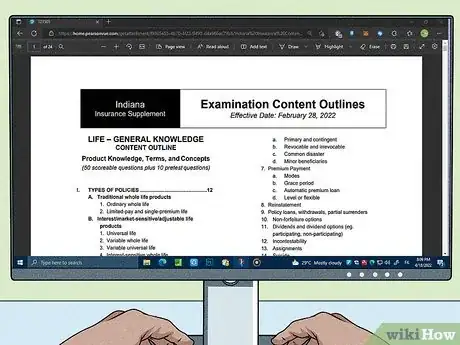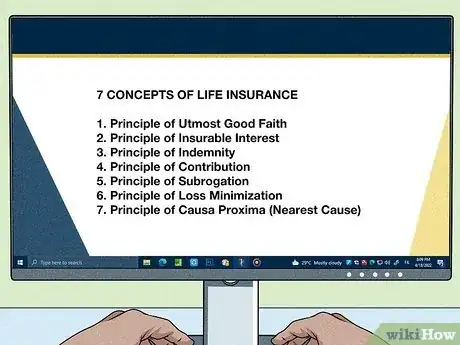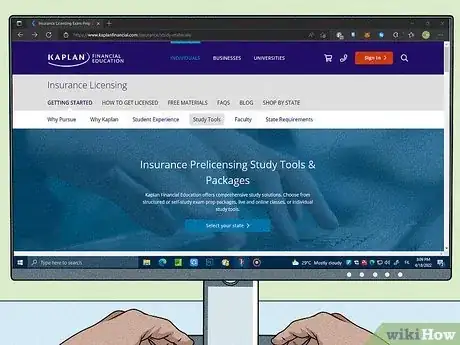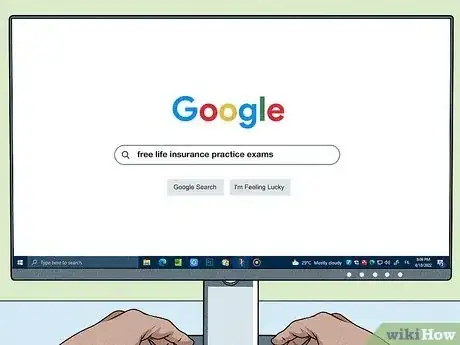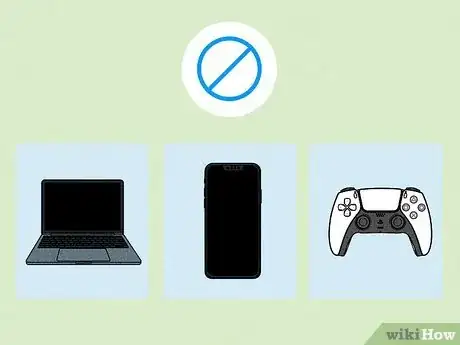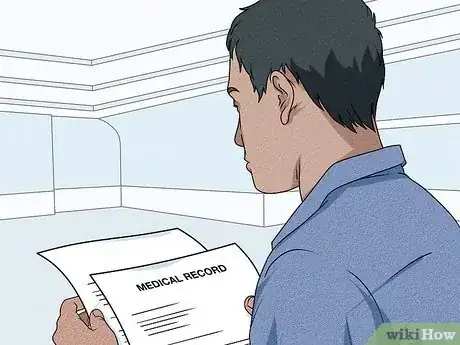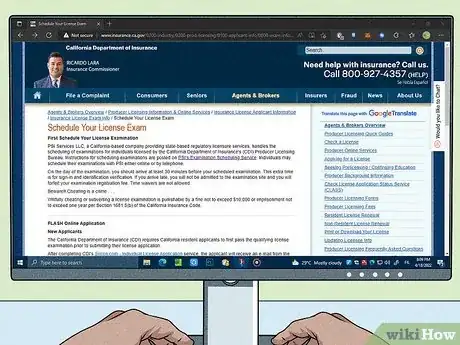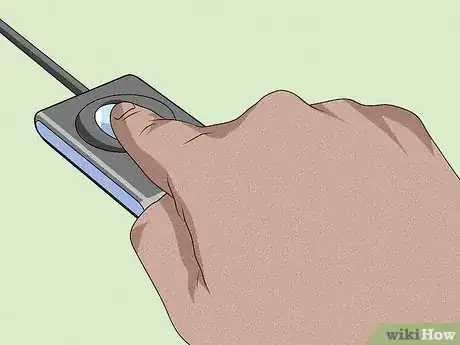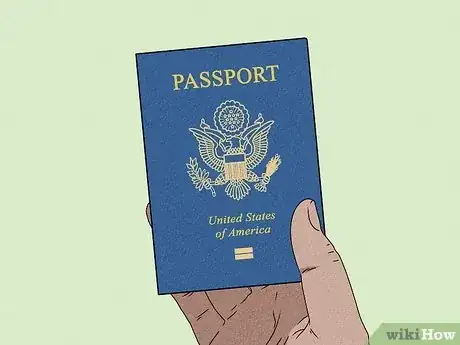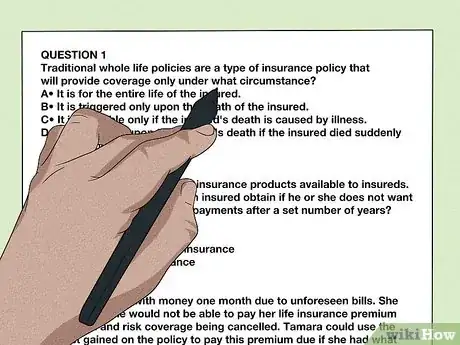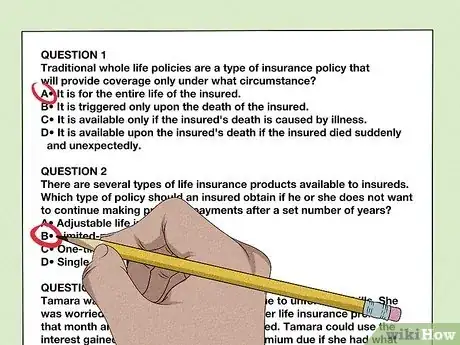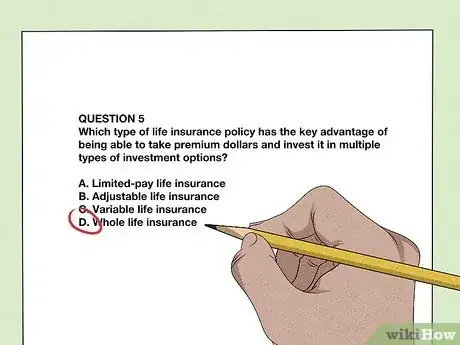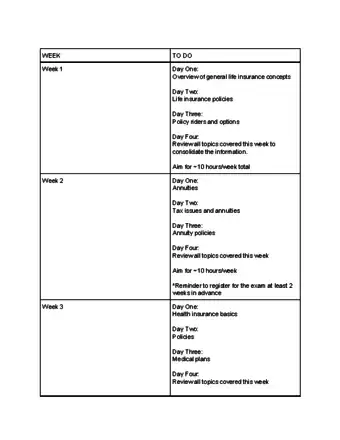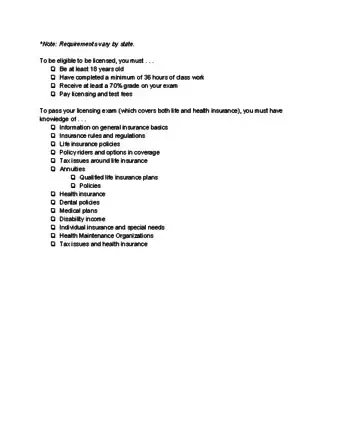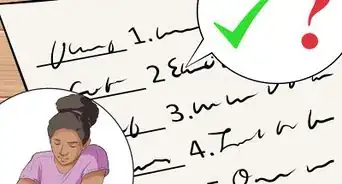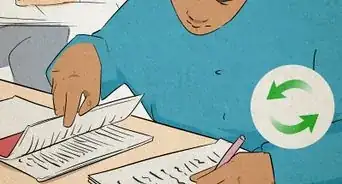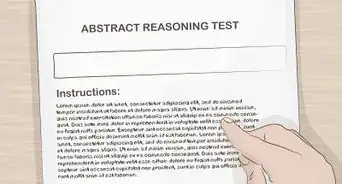This article was co-authored by wikiHow staff writer, Madeleine Flamiano. Madeleine Flamiano is an Editing Fellow at wikiHow based in Berkeley, California, as well as a Team Organizer, Copy Editor, and Movie Critic for Incluvie. Madeleine has 12 years of experience in literacy advocacy and the creative arts that span tutoring, teaching, writing, public relations, and non-profit support. She has penned seven novels under a pseudonym and loves all escapist genres, from cozy fantasies to hard-boiled sci-fi. Her professional path started at NaNoWriMo, where she scripted and hosted a series on worldbuilding. Madeleine graduated from Mills College with a B.A. in English with a concentration in Literature and a Minor in Philosophy.
There are 7 references cited in this article, which can be found at the bottom of the page.
This article has been viewed 43,731 times.
Learn more...
Eager to pass your life insurance exam but need the right game plan? No matter what type of insurance company you're looking to work with, you'll have to master this important test in order to earn your life insurance license. Luckily, all you have to do is build the right study habits and break the exam down into easy steps. Jump right into this guide to learn all the basics to passing your life insurance exam so you can start a rewarding new career!
Steps
Studying for the Exam
-
1Plan to devote about 35-40 hours of study time to your exam. The life insurance exam covers a number of complex topics, ranging from annuities to health maintenance organizations (HMO's). In order to pass the exam, try to arrange your schedule so you can free up 35-40 hours to study the content for your test.[1]
- While 35-40 hours may seem like a lot of time, just remember that the time you invest in studying will help you open up a new career path in insurance sales.
-
2Download the State Exam Outline. Visit your state's official department of insurance website, which provides an updated outline of their life and health exam. Read the outline that's tailored to your state's regulations to get a general overview of what topics are covered on the test and how many questions are devoted to them. [2]
- Every state exam outline is specially designed by professionals in the insurance industry.
- The content in the state exam outlines will help you get a feel for the duties you'll perform as an entry-level insurance professional.
- Make sure to review general topics related to both life and health insurance.
- Look into how annuities, special contracts, help people save for their retirement.
- Review how HMOs offer coverage from a specific network of doctors.
- Create a "cheat sheet" with key info from your state exam outline and review it every day.
Advertisement -
3Focus on the core concepts of life insurance. To familiarize yourself with the 7 core concepts of life insurance, focus on all the unique ways that insurance contracts address either personal injuries or car accidents. Start by reading a brief review of each key item. Then, reflect on what would “breach,” or go against, these important 7 principles:
- Principle of Utmost Good Faith: the policyholder and the insurer should act in “good faith,” or with honesty and positive intentions.
- Principle of Insurable Interest: the item or property listed in a contract, such as a car, is worth money, so the insurer or policyholder would face a financial loss if it was damaged
- Principle of Indemnity: a promise to repay the policyholder for any losses that they suffered from an injury of accident
- Principle of Contribution: each insurance company a policyholder has a contract with will cover the amount of losses they originally agreed to pay for
- Principle of Subrogation: the policyholder has the ability to substitute one insurance company for another one
- Principle of Loss Minimization: it is the policyholder’s responsibility to avoid injuries or accidents as much as possible
- Principle of Causa Proxima (Nearest Cause): not all losses are likely to be covered by one type of insurance contract
-
4Take a prelicensing education course. Register to take live classes, online courses, or to obtain printed study material geared towards your exam. Taking a course will also help you organize your study material and set a realistic study schedule. Even though only some states require you to take a prelicensing education course before your exam, you'll have a huge advantage if you pursue this type of professional development.[3]
- Lots of online academies, like Kaplan University, offer prelicensing education courses.
- Go through materials online and see which is best for you—for example, you may like pre-recorded lectures more than PDFs.
- Any study guide you choose will walk you through the License Exam Manual (LEM) so you can review important basics for the life and health insurance licensing exam.
-
5Search online for free practice exams. Search through the variety of free life insurance practice exams available online. Take as many practice exams as you can—that way, you can test your knowledge and to get a feel for the structure of the exam. Then, use the results of your exam to see where you need to focus more study time.
- For example, you can try a practice test provided online by Prometric, a company that is a test provider in multiple states.
- Note the areas where you really excel for a great confidence boost and to highlight topics that need less study time.
- Make a list of questions you answered incorrectly so you're aware of content that will need more review.
-
6Remove any distractions from your study environment. Make the most of your study time by eliminating all the "noise" that might keep you from focusing. Turn off your phone and avoid scrolling through sites like YouTube or Instagram while you work. Choose a quiet study spot away from friends, family, or crowds of people.
- Pop in some headphones and listen to soothing instrumental music to let anyone around you know you need to concentrate.
- If the place you're in is too loud—maybe there's a lot of activity at your house or a coffee shop—go to a spot that's guaranteed to be quiet, like a library.
- Make sure you have a lot of snacks and water nearby so you can keep your energy up while you study.
Learning the Main Concepts
-
1Study the types of life insurance policies available. Review each and every type of life insurance that may appear on the life and health exam, including term life insurance, whole life insurance, and variable life insurance. Aim to have a clear understanding of the guidelines that surround each type of insurance.
-
2Review life insurance contracts. Take time to outline how specific details of a life insurance policy are legally binding. To successfully tackle your life insurance exam, make a list of all the important components of a life insurance contract, including how beneficiaries are named, how premiums are established, and how provisions and riders are added.[4]
- If you get more familiar with life insurance contracts, you'll be able to help your clients choose the right one in the future.
- Focus on how you can translate jargon—technical industry terms—and break them down into concepts that are easy for you and others to understand.
-
3Learn the process of underwriting. Study the process of "underwriting," the way insurance providers calculate the risk involved in insuring someone. Then, use this info to come up with a life insurance quote. To get an accurate quote, research an individual's medical history and driving record. In order to get the best grasp on underwriting, prepare yourself for questions on how specific "risks" affect insurance quotes.[5]
- As one hypothetical scenario, focus on how a person's prescription drug history might contribute to a high quote.
-
4Read up on tax issues related to life insurance policies. Lots of policyholders are really concerned about taxes, so make sure to thoroughly review all tax laws that can impact clients. Study tax issues related to life insurance that clients may face and be ready to explain how they'll affect policyholders' contracts. For instance, prepare to answer questions about how life insurance proceeds, or payouts, are taxed, when these taxes are paid, and how policyholders can avoid too much taxation.
Registering for the Exam
-
1Schedule your exam online or by phone 2 weeks in advance. Visit the website for your state's department of insurance to find out what scheduling options you have. Book your exam time at least 2 weeks in advance for a better chance of getting the slot you want.
- Most states allow you to choose the date and time of your exam.
-
2Pay a fee for your exam. Since most states charge a fee to take their life insurance exam, expect to pay between $40-$150. Follow the instructions given to you when you book your exam to pay the fees.
- Many states will allow you to pay online with a credit card and require you to pay before taking the exam.
- Exam fees are usually not refundable in the event that you cancel your appointment less than 24 hours in advance or miss your designated test time.
-
3Submit your fingerprints for a pre-exam background check. Many states require you to pass a background check before taking your exam, so make sure you get your fingerprints scanned. Call your state's department of insurance or visit its website to find out its specific requirements for fingerprinting—you'll probably need to visit a local law enforcement agency. Ask any agents taking your fingerprints if an extra fee needs to be paid for the fingerprint test or if it is included in your license application.
- Keep in mind that different states have their own systems. For example, in Wyoming, you'll be sent a fingerprint packet by mail to be completed at the nearest law enforcement agency.
-
4Bring a piece of government-issued picture ID with you. When you arrive at the exam location, you will have to sign in. Be sure to bring a piece of photo ID to verify who you are before taking the test. If you don't have a valid, government-issued ID, you probably won't be able to sit for your exam and you will likely lose the fee you paid to take it.[6]
- A driver's license or passport are good pieces of ID to bring with you.
Taking the Exam
-
1Read the questions thoroughly before answering them. Most questions on the life and health exam will have lots of details and cover very niche, specific scenarios. Read through each question carefully at least 2 times before attempting to answer it. Focus only on the information contained in the question and avoid making assumptions to fill in any blanks.[7]
-
2Answer the questions you're confident about first. To use your exam time efficiently, go through the test and answer all of the questions that feel easy and intuitive. It's better to move on than to stay focused on questions that you're stuck on. After you go through the exam, return to the questions you left blank and do your best to answer them.
-
3Guess the answer instead of leaving a difficult question blank. Do not leave any questions on the exam blank if you do not know the answer since you won't be penalized for wrong answers. Guess an answer so you'll benefit from a 25% chance of getting it right. If you can eliminate any of the multiple choice options that you know to be incorrect, you'll have any even better chance of getting the answer right.
-
4Celebrate a passing score or retake the exam. Either way, persistence is key—you'll master the test eventually! To pass your life insurance exam, you'll need to receive a 70% score or above. If you diligently studied for the recommended amount of 35-40 hours a week, this should be very achievable. However, if you don't pass right away, don't worry. Just sign up for another exam and use the time before your next test date to review all the necessary material again.
- If you need to retake the test, try a crash course for insurance licensing exam prep so you can conquer your next exam.
Study Schedule and Exam Checklist
Expert Q&A
-
QuestionWhat is the passing marks ?
 wikiHowOur goal at wikiHow is to deliver trustworthy articles that engage our readers and meet their informational and emotional needs. For 15 years, we've committed to our step-by-step teaching model, and we continue to refine our content to create the best how-to experience on the Internet. We’ve helped millions of people solve problems, learn new skills, and feel supported in the ordinary and complex moments of life.
wikiHowOur goal at wikiHow is to deliver trustworthy articles that engage our readers and meet their informational and emotional needs. For 15 years, we've committed to our step-by-step teaching model, and we continue to refine our content to create the best how-to experience on the Internet. We’ve helped millions of people solve problems, learn new skills, and feel supported in the ordinary and complex moments of life.
The most trusted how-to site on the internet. All states consider a 70% score or greater a passing score for your life insurance exam. If you receive this mark, then you're good to go!
All states consider a 70% score or greater a passing score for your life insurance exam. If you receive this mark, then you're good to go!
References
- ↑ https://www.kaplanfinancial.com/resources/insurance/how-hard-is-the-life-and-health-insurance-exam/
- ↑ https://www.in.gov/idoi/2480.htm
- ↑ https://www.kaplanfinancial.com/resources/insurance/how-to-pass-the-life-and-health-insurance-exam
- ↑ https://www.nerdwallet.com/blog/insurance/essential-terms-life-insurance-buyers/
- ↑ https://www.nerdwallet.com/blog/insurance/essential-terms-life-insurance-buyers/
- ↑ https://blog.tesu.edu/7-mistakes-the-night-before-a-big-test-you-will-never-make-again
- ↑ http://www.nationalonlineinsuranceschool.com/insurance-license-blog/2012/11/top-insurance-license-exam-tips/

